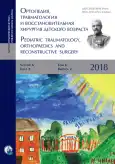Congenital contracture of the iliotibial tract: a case report
- Authors: Garkavenko Y.E.1,2, Krasnogorskiy I.N.1, Dolgiev B.H.1
-
Affiliations:
- The Turner Scientific Research Institute for Children’s Orthopedics
- North-Western State Medical University n.a. I.I. Mechnikov
- Issue: Vol 6, No 2 (2018)
- Pages: 79-85
- Section: Exchange of experience
- URL: https://bakhtiniada.ru/turner/article/view/8993
- DOI: https://doi.org/10.17816/PTORS6279-85
- ID: 8993
Cite item
Abstract
Introduction. Congenital contracture of the iliotibial tract is a rather rare pathology that causes difficulties in diagnosing and planning treatment activities. The lack of a clear idea of the causes of the disease has led to disagreement in the interpretation of the diagnosis in patients with this pathology. In the Russian-language literature, this disease is referred to as idiopathic extension and abduction contracture of a hip joint or idiopathic contracture of the dorsal gluteal muscle (a congenital contracture of the tendons of the dorsal gluteal muscles), whereas the English-language literature more often highlights congenital or idiopathic contracture of the dorsal gluteal muscles.
Clinical сase. The results of treatment of a 6-year-old child with congenital contracture of the iliotibial tract is presented. The child exhibited lameness when walking first started, but the correct diagnosis was not established. Clinically, along with the limitation of adduction and extension in the hip joint and an induration of the soft tissue along the external surface of the right thigh, the pelvis was skewed, and there was shortening of the right lower limb and a valgus deformity of diaphysis of the right femoral bone. Ultrasonographic and magnetic resonance imaging indicated the presence of a fibrous bridle over the outer surface of the right thigh. The fibrous bridle was excised for 15 cm, and a temporary hemiepiphysiodesis of the medial portion of the distal growth zone of the right femur was performed.
Results and discussion. At the 1-year control examination, the patient did not present any complaints. There was no relapse of the contracture. According to X-ray study results, correction of the valgus deformity of the right femur was achieved, and the metal structures were removed. Despite the more frequent extension and abduction direction of the contracture of the iliotibial tract indicated by most authors, the direction and severity apparently may depend on the predominant zone of fibrous degeneration of the muscle groups. Additionally, with the predominant lesion of the dorsal gluteal muscle, a more pronounced extension component can be expected, whereas with the predominant lesion of the musculus tensor fasciae latae, a flexion component can be expected and was observed in our patient.
Keywords
Full Text
##article.viewOnOriginalSite##About the authors
Yuriy E. Garkavenko
The Turner Scientific Research Institute for Children’s Orthopedics; North-Western State Medical University n.a. I.I. Mechnikov
Author for correspondence.
Email: krasnogorsky@yandex.ru
Leading Research Associate of the Department of Bone Pathology; MD, PhD, Professor of the Chair of Pediatric Traumatology and Orthopedics
Russian Federation, 64, Parkovaya str., Saint-Petersburg, Pushkin, 196603; 41, Kirochnaya street, Saint-Petersburg, 191015Ivan N. Krasnogorskiy
The Turner Scientific Research Institute for Children’s Orthopedics
Email: krasnogorsky@yandex.ru
MD, PhD, senior research associate histologist of the scientific and morphological laboratory
Russian Federation, 64, Parkovaya str., Saint-Petersburg, Pushkin, 196603Bahauddin H. Dolgiev
The Turner Scientific Research Institute for Children’s Orthopedics
Email: krasnogorsky@yandex.ru
MD, Orthopedic and Trauma Surgeon of the Department of Bone Pathology
Russian Federation, 64, Parkovaya str., Saint-Petersburg, Pushkin, 196603References
- Кожевников О.В., Кралина С.Э. Анализ ошибок при диагностике, лечении и проведении реабилитационных мероприятий наиболее распространенной ортопедической патологии у детей на этапе амбулаторно-поликлинической помощи // Научно-практическая конференция с международным участием «Медицинская реабилитация в педиатрической практике: достижения, проблемы и перспективы»; Июль 1, 2013; Якутск. – Якутск, 2013. [Kozhevnikov OV, Kralina SE. Analysis of errors in the diagnosis, treatment and rehabilitation of the most common orthopedic pathology in children at the stage of outpatient care. In: Proceedings of the Scientific-practical conference with international participation “Medical rehabilitation in pediatric practice: achievements, problems and prospects”; 2013 Jul 1; Yakutsk. (Conference proceedings). Yakutsk; 2013. (In Russ.)]
- Джураев А.М., Кадыров И.М. Клинические аспекты диагностики и лечения разгибательно-отводящей контрактуры тазобедренного сустава у детей // Вiсник ортопедii, травматологii та протезування. – 2009. – № 1. – С. 40–42. [Dzhuraev AM, Kadyrov IM. Clinical aspects of diagnosis and treatment of extensor-deflecting hip contracture in children. Visnyk ortopedii, travmatolohii ta protezuvannia. 2009;(1):40-42. (In Russ.)]
- Нарходжаев Н.С., Жуманов Т.Т. Опыт хирургического лечения врожденной контрактуры сухожилий больших ягодичных мышц у детей // Вестник Южно-Казахстанской государственной фармацевтической академии. – 2015. – № 4. – С. 64–66. [Narkhodzhaev NS, Zhumanov TT. Experience of surgical treatment of the congenital contracture of sinews of big gluteuses at children. Vestnik of the South-Kazakhstan State Pharmaceutical Academy. 2015;(4):64-66. (In Russ.)]
- Zhao CG, He XJ, Lu B, et al. Classification of gluteal muscle contracture in children and outcome of different treatments. BMC Musculoskelet Disord. 2009;10:34. doi: 10.1186/1471-2474-10-34.
- Kotha VK, Reddy R, Reddy MV, et al. Congenital gluteus maximus contracture syndrome — a case report with review of imaging findings. J Radiol Case Rep. 2014;8(4):32-37. doi: 10.3941/jrcr.v8i4.1646.
- Pathak A, Shukla J. Idiopathic Bilateral Gluteus Maximus Contracture in Adolescent Female: A Case Report. J Orthop Case Rep. 2013;3(1):19-22.
- Rai S, Meng C, Wang X, et al. Gluteal muscle contracture: diagnosis and management options. SICOT J. 2017;3:1. doi: 10.1051/sicotj/2016036.
- Ye B, Zhou P, Xia Y, et al. New minimally invasive option for the treatment of gluteal muscle contracture. Orthopedics. 2012;35(12):e1692-1698. doi: 10.3928/01477447-20121120-11.
- Ni B, Li M. The effect of children’s gluteal muscle contracture on skeleton development. Sichuan Da Xue Xue Bao Yi Xue Ban. 2007;38(4):657-659.
- Островерхов Г.Е, Лубоцкий Д.Н., Бомаш Ю.М. Курс оперативной хирургии и топографической анатомии. – М.: Медгиз, 1963. [Ostroverhov GE, Lubotskiy LN, Bomash YM. Course of operative surgery and topographic anatomy. Moscow: Medgiz; 1963. (In Russ.)]
- Попелянский Я.Ю. Ортопедическая неврология (вертеброневрология). Руководство для врачей. – М.: МЕДпресс-информ, 2011. [Popelyanskiy YY. Orthopedic neurology (vertebroneurology). A guide for doctors. Moscow: Medpress-inform; 2011. (In Russ.)]
Supplementary files

















